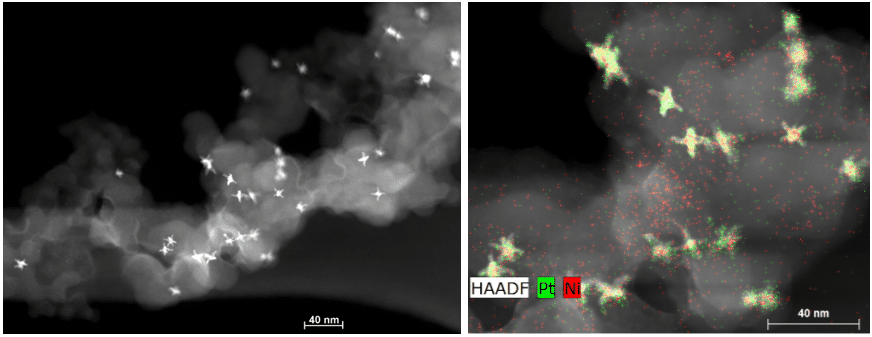
Pt-RICH PtNi HEXAPOD FROM Ni-RICH PtNi OCTAHEDRA FOR OXYGEN REDUCTION REACTION
2Department of Advanced Electron Microscopy, Imaging and Spectroscopy, International Iberian Nanotechnology Laboratory (INL), Braga, Portugal
3Materials Science and Engineering Program, The University of Texas at Austin, Austin, Texas, USA
4Mechanical Engineering Department and IDMEC, Instituto Superior Técnico, University of Lisbon, Lisbon, Portugal
Pt-Ni bimetallic alloys have received a lot of attention since they show orders of magnitude better oxygen reduction reaction (ORR) activity than pure Pt. In this work, we succeeded in synthesizing Pt-Ni hexapods with homogeneous shape, size and composition. Since Pt and Ni metals form a solid solution through the entire phase diagram, Ni-rich Pt-Ni alloyed nanocrystals might be de-alloyed to yield Pt-rich Pt-Ni via Ni removal through specific chemical etching in a two-phase approach. In this strategy, the nanocrystals are dispersed in the upper organic phase where they are etched, while the Ni(II) complexes are transferred to the aqueous phase with coordination by EDTA. This phase-transfer approach promotes the precise etching and yields Pt-rich Pt-Ni hexapods. This work involved the characterization of the materials by high-angle annular dark field (HAADF) scanning transmission electron microscopy (STEM), using an aberration-corrected FEI TITAN Themis operated at 200 kV coupled to an Energy Dispersive Spectrometer (EDS), as well as X-ray diffraction (XRD) and X-ray Fluorescence (XRF).

HAADF-STEM and EDS images of Pt-rich Pt-Ni hexapods
Powered by Eventact EMS